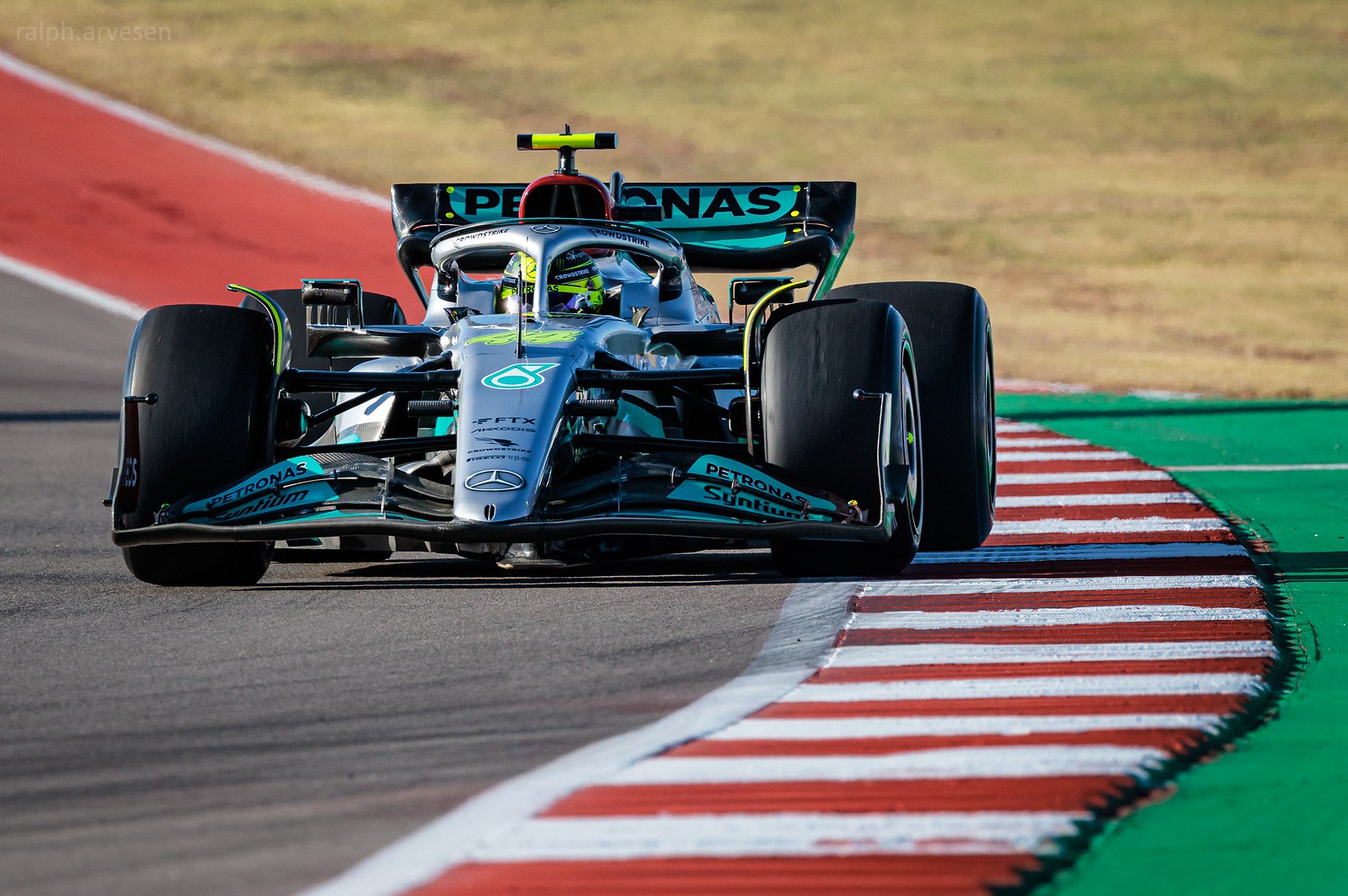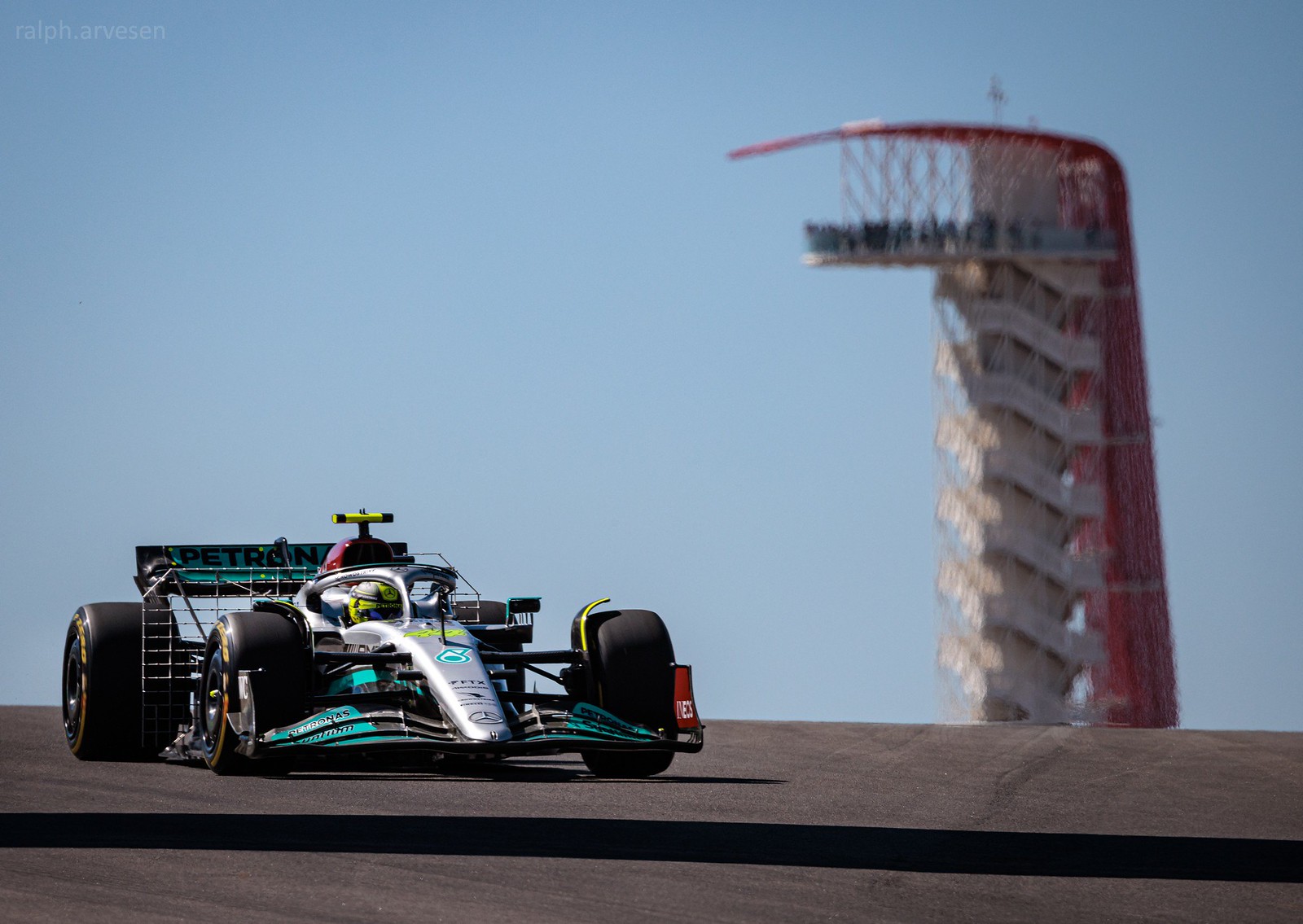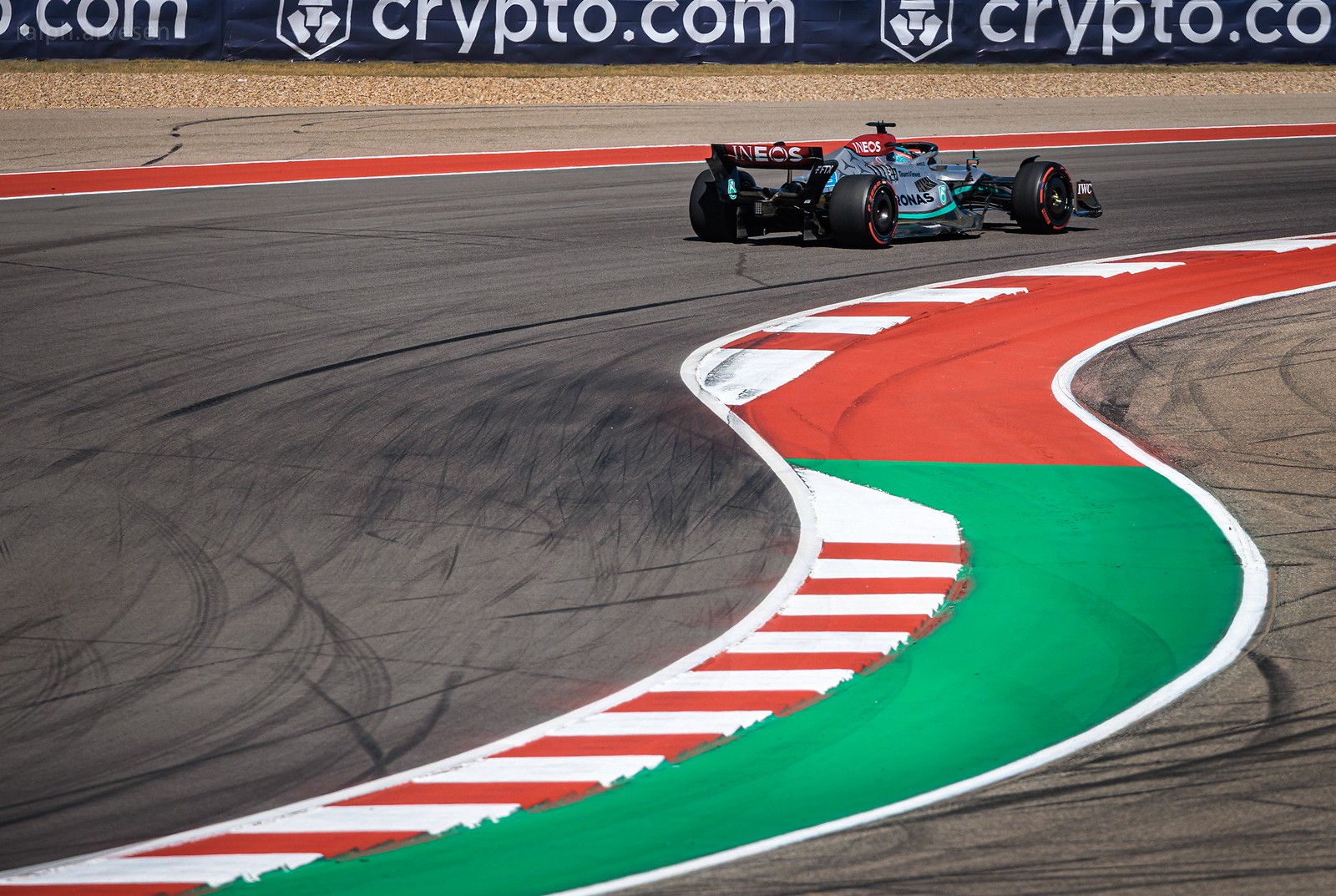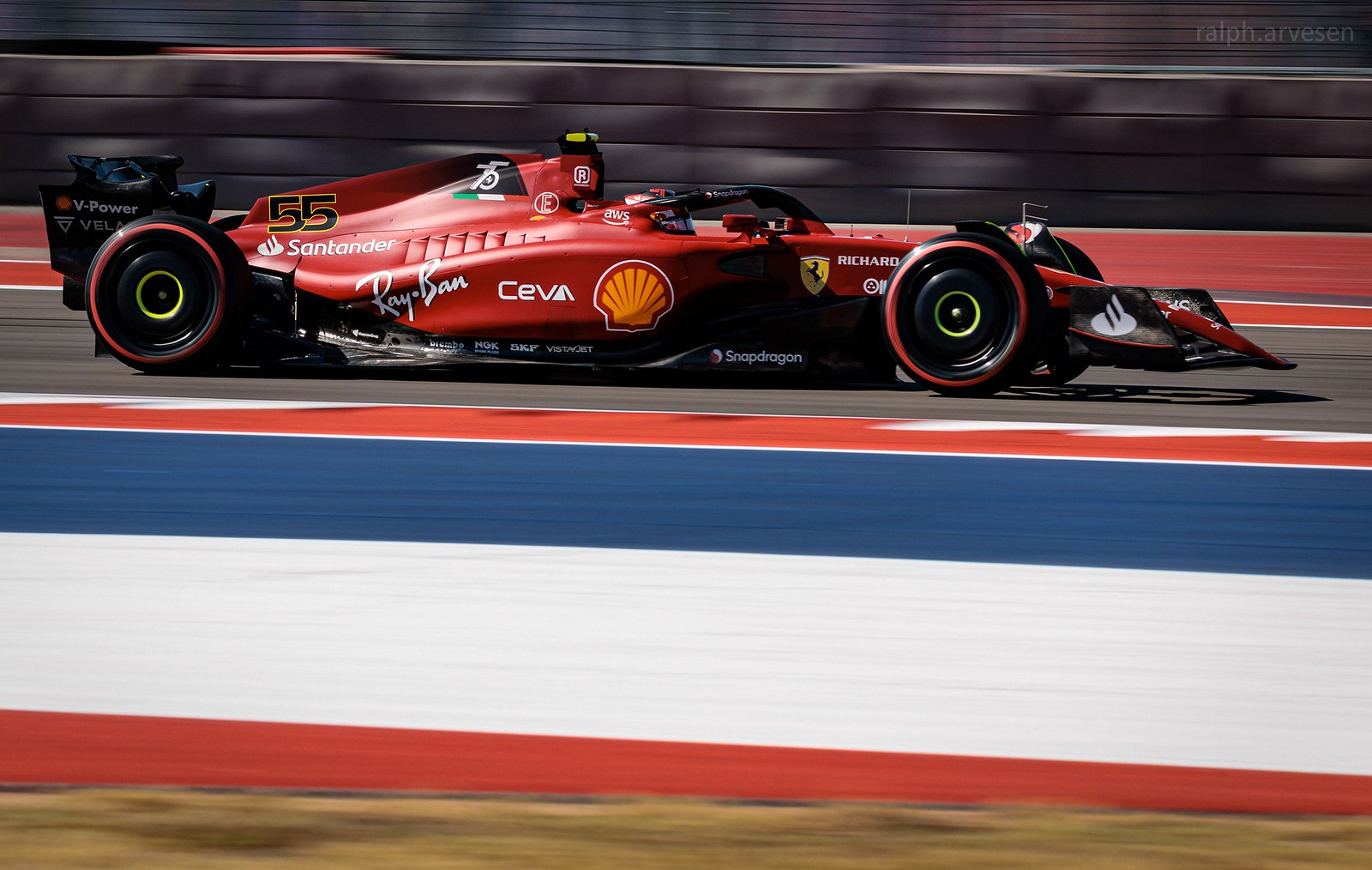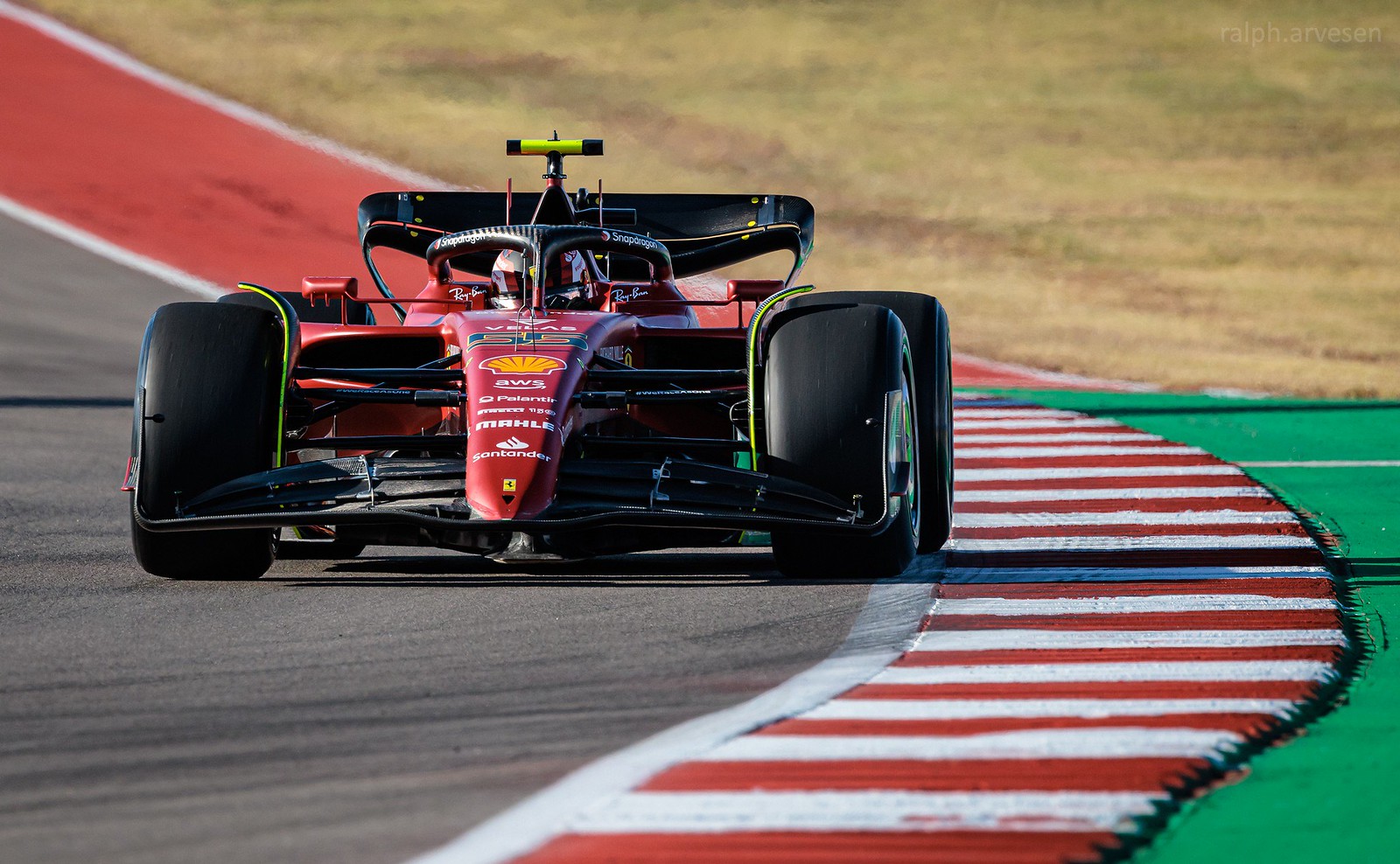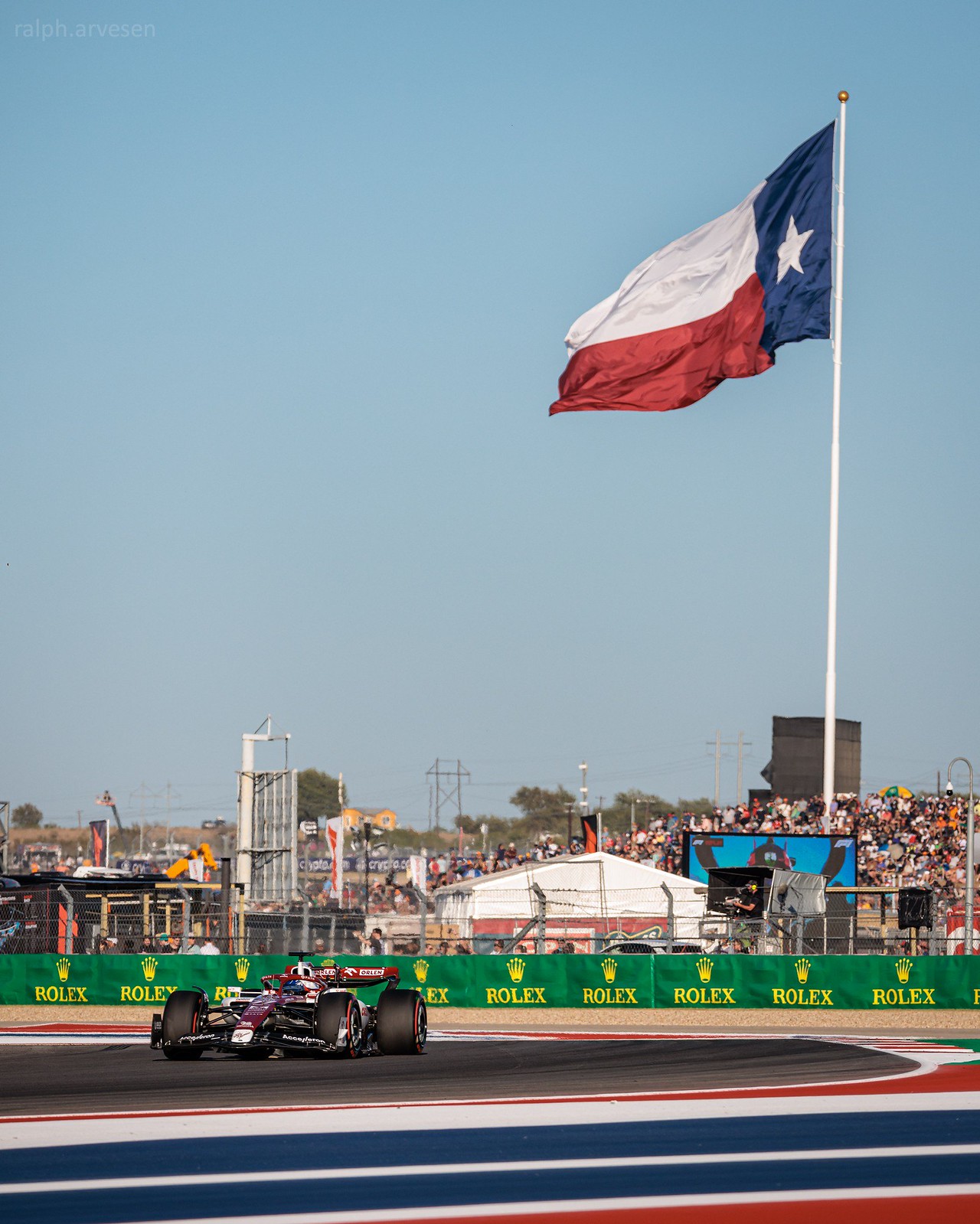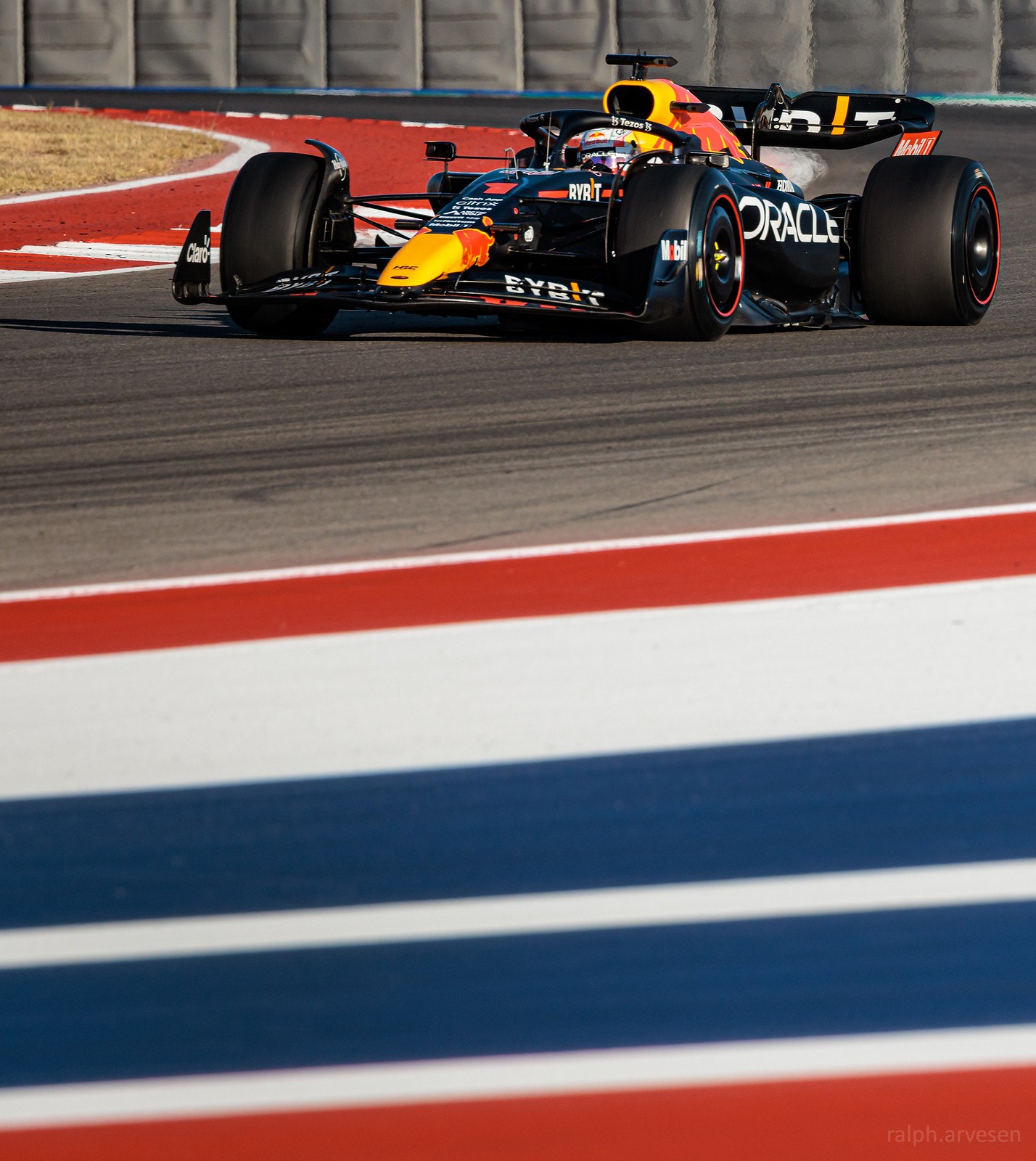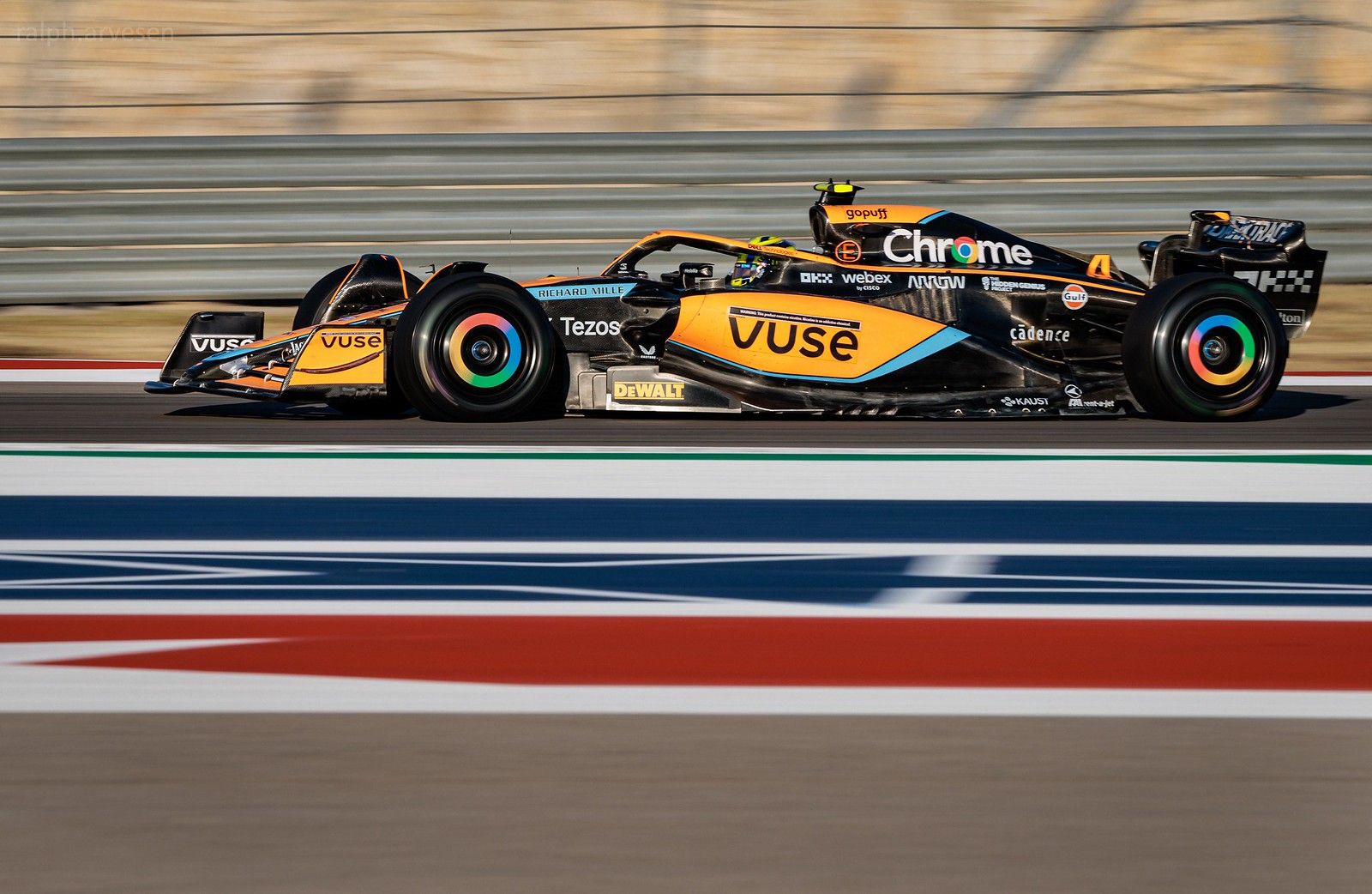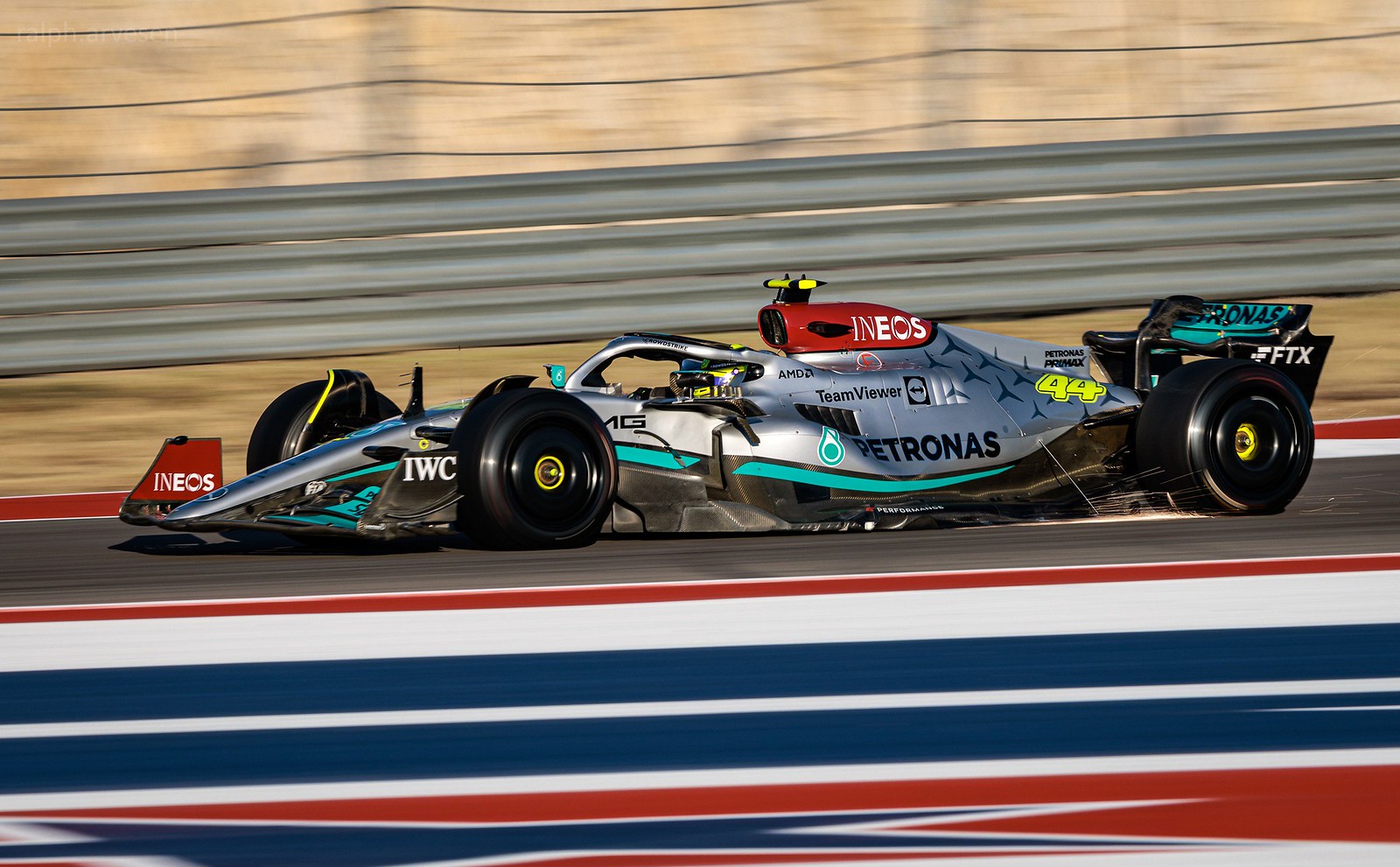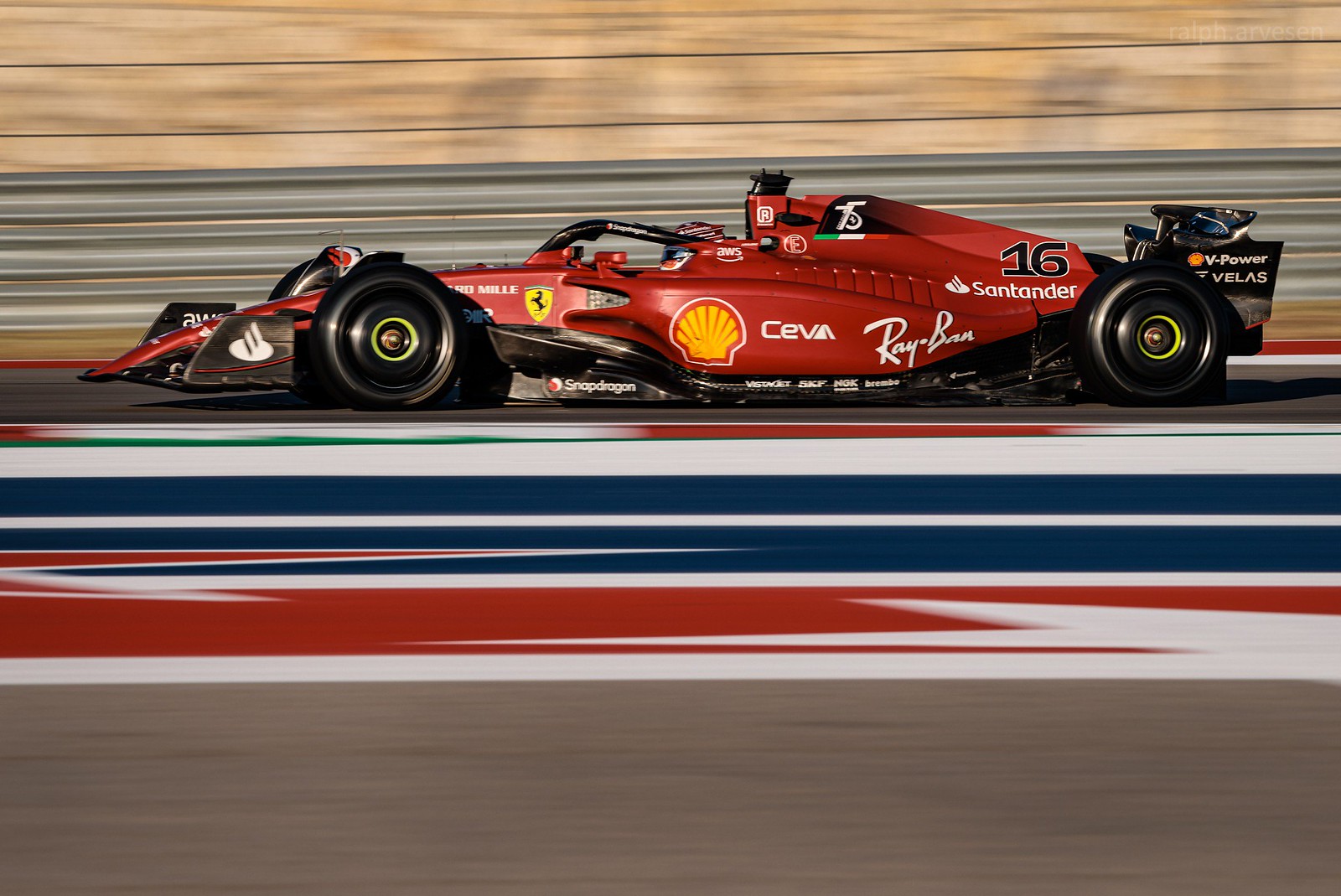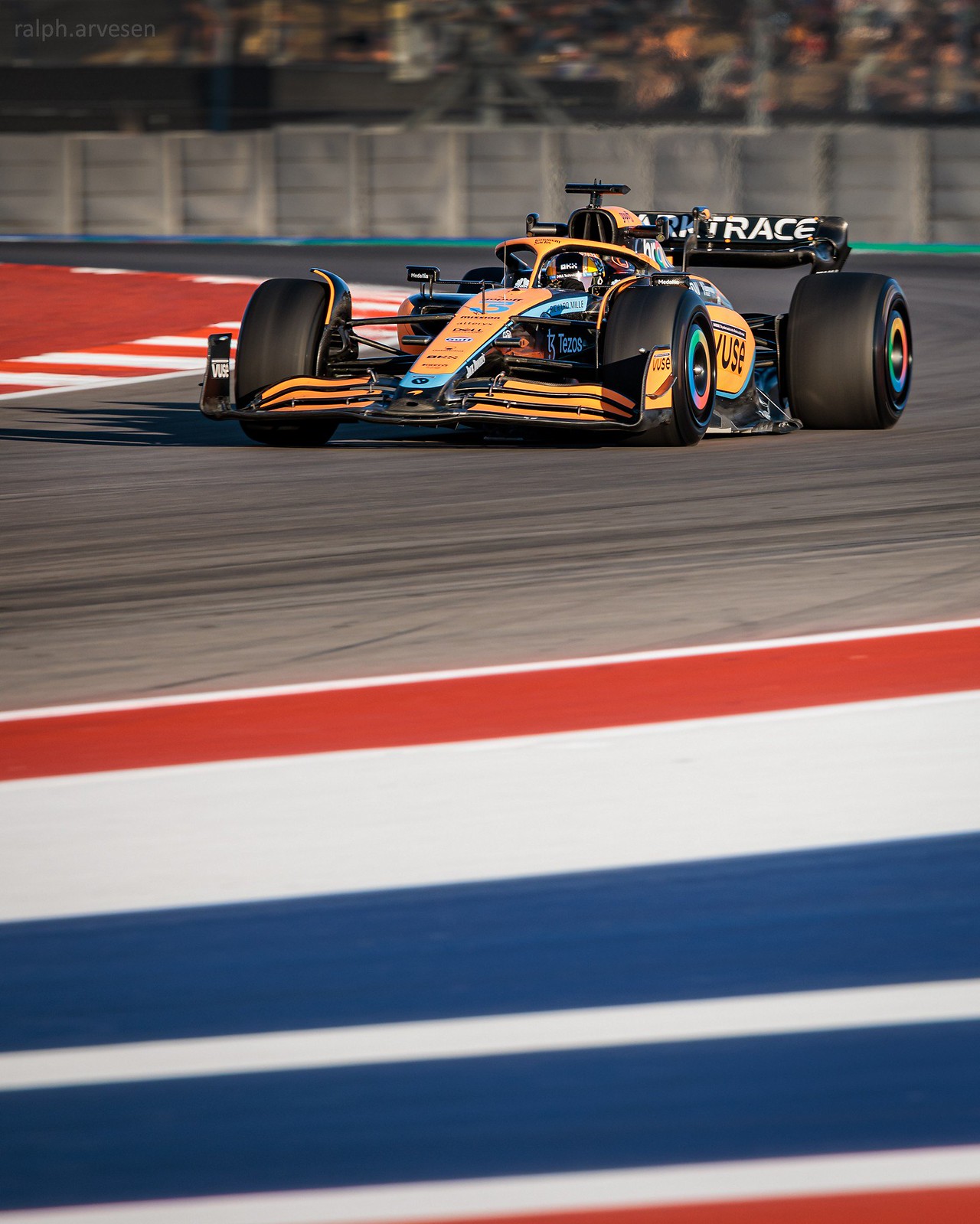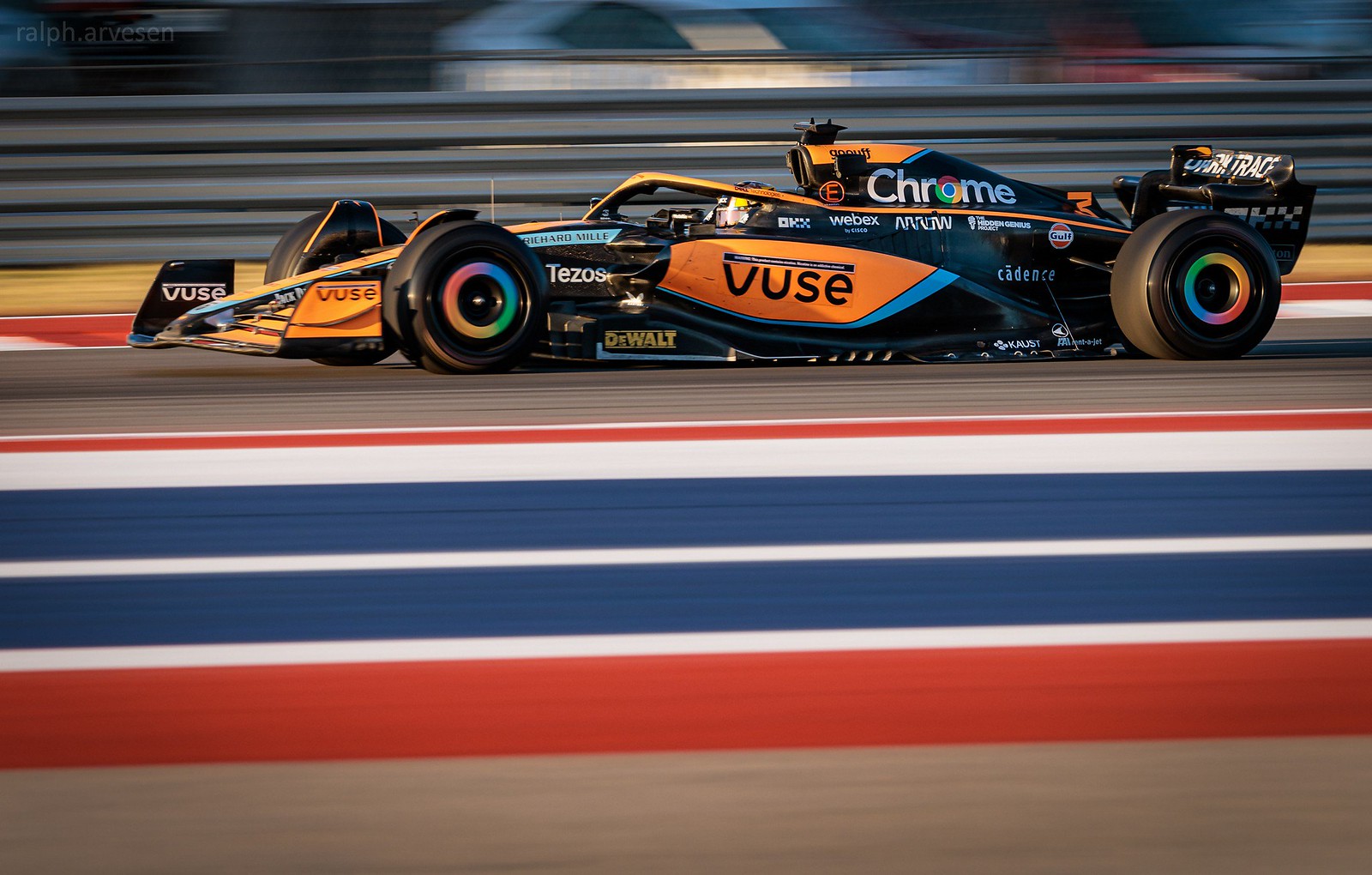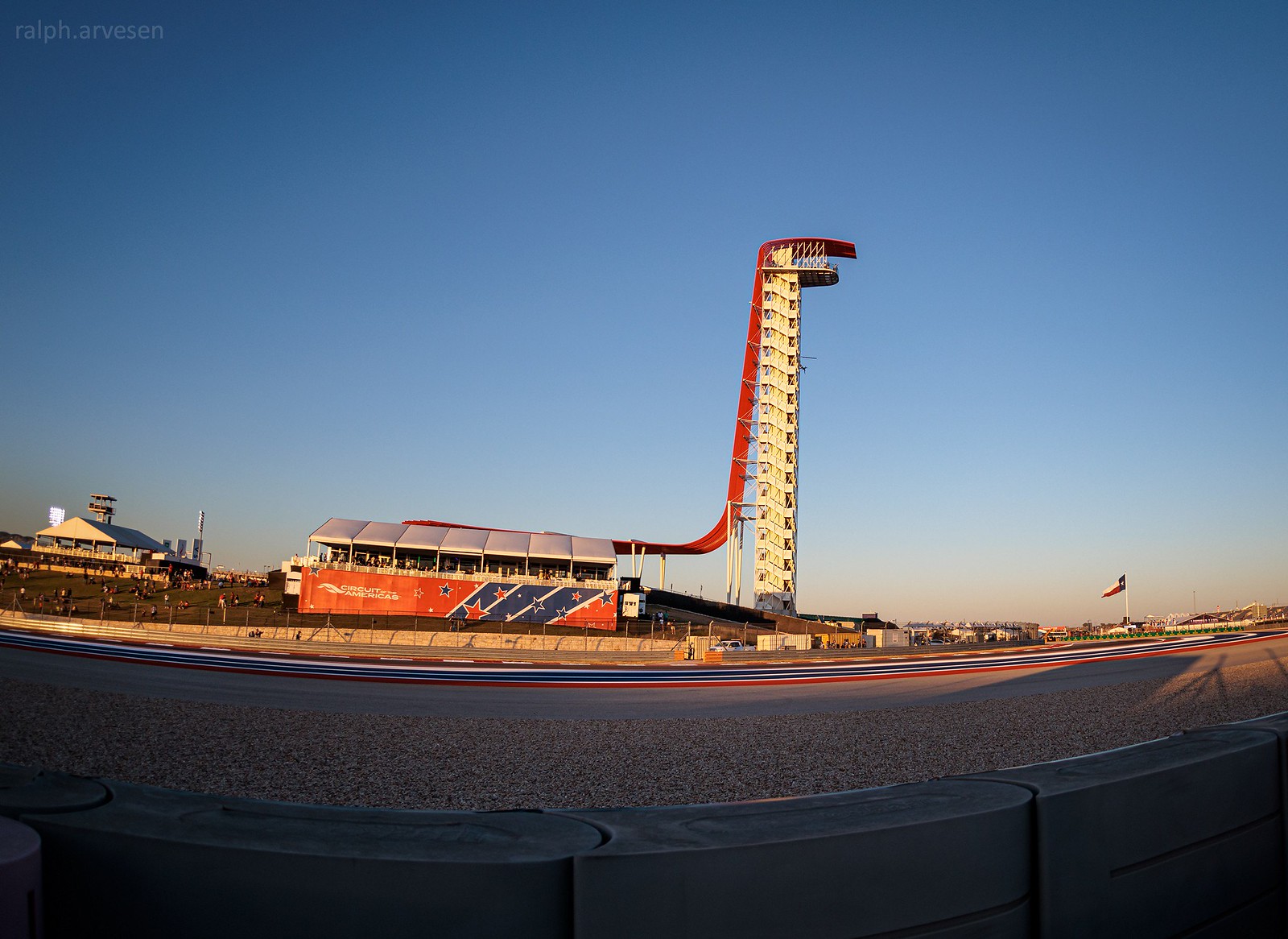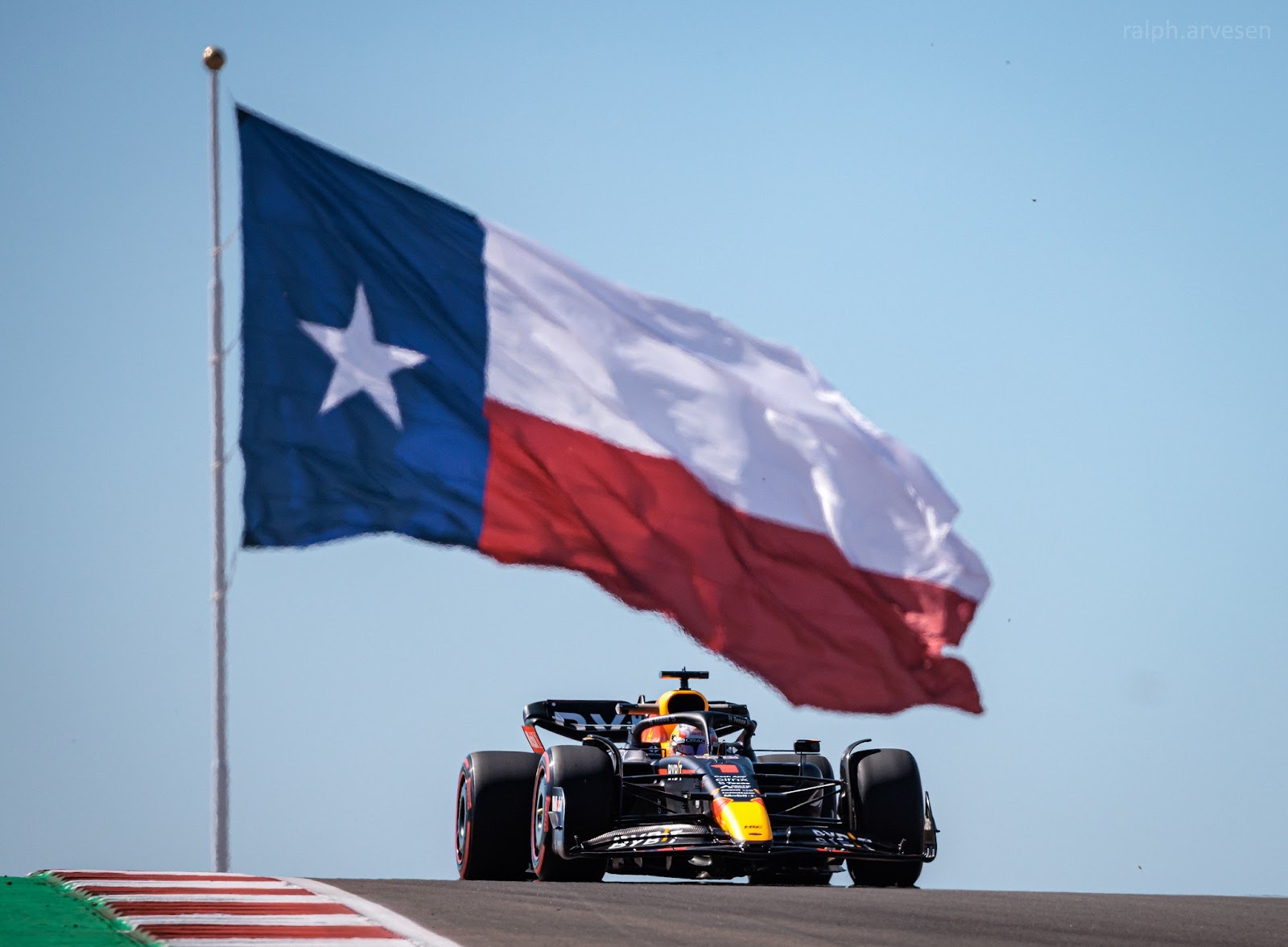
Formula 1 Aramco United States Grand Prix 2022 practice at the Circuit of The Americas in Austin, Texas on October 21-22, 2022. (Photo: Ralph Arvesen)
Practice 1
Carlos Sainz set the fastest time ahead of Max Verstappen in the opening practice for the 2022 United States Grand Prix, with four drivers making their FP1 debut at Austin. Ferrari driver Sainz set the fastest time of 1m 36.857s with Red Bull’s champion Verstappen jumping to second late on, 0.224s off the Spaniard’s pace. Lewis Hamilton therefore finished third, just under half a second off the pace in a Mercedes sporting its final major upgrade package of the season. Lance Stroll finished fourth for Aston Martin, leaving Red Bull driver Sergio Perez – who will receive a grid penalty for his fifth internal combustion engine of the season – rounding out the top five.
Five drivers were substituted in for FP1 as per the 2022 regulations: Robert Shwartzman in place of Charles Leclerc at Ferrari; Alex Palou in place of Daniel Ricciardo at McLaren; Logan Sargeant in place of Nicholas Latifi at Williams; Theo Pourchaire in place of Valtteri Bottas at Alfa Romeo; and Antonio Giovinazzi returning to the wheel in place of Kevin Magnussen at Haas. Seven minutes into the session, Giovinazzi’s Haas swapped ends and he hit the barriers outside Turn 6 with the right-hand side of his car, bringing out a brief red flag. The Italian driver managed to get his car going again and limp back to the pits – but a damaged clutch left him last on the timesheets and out of the session.
Fernando Alonso finished sixth for Alpine with Mercedes’ George Russell just under a tenth behind in P7 for Mercedes, and Pierre Gasly another 0.008s back in P8 for AlphaTauri. Behind ninth-place McLaren driver Lando Norris, Sebastian Vettel rounded out the top 10 for Aston Martin ahead of Esteban Ocon and Zhou Guanyu, the 12th-placed Alfa Romeo driver also set to take a grid penalty for his fifth power unit of 2022. Alex Albon took 13th for Williams, leaving Yuki Tsunoda 14th for AlphaTauri and Mick Schumacher 15th for Haas. As a result, the four rookies were next on the timesheets with Ferrari’s Shwartzman 0.030s off Schumacher in P16. Palou finished 17th and Pourchaire 18th – both drivers only running mediums – while the home favourite Williams driver Sargeant finished 19th.
Practice 2
Ferrari driver Charles Leclerc posted the fastest time in FP2 for the 2022 United States Grand Prix – this session lengthened from 60 to 90 minutes for Pirelli’s prototype 2023 tyre test. Leclerc clocked a 1m 36.810s during an early stint on the 2022-spec medium tyre, having been allowed to run his own programme at the start of the session after sitting out FP1. With weather conditions hot and sunny at the Circuit of The Americas, it proved to be an ideal session for Pirelli to gather representative data on their work-in-progress compounds prior to a planned post-season test for the definitive versions in Abu Dhabi.
Alongside Leclerc and Ferrari, several other drivers and teams conducted bespoke programmes for a portion of FP2 before focusing on the tyre test, with McLaren, Alfa Romeo, Williams and Haas also given dispensation for running ‘rookie’ drivers in FP1. Indeed, FP2 marked the first laps of the weekend for Leclerc, Daniel Ricciardo, Valtteri Bottas, Nicholas Latifi and Kevin Magnussen – the latter looking to recover lost mileage at Haas after Antonio Giovinazzi’s crash in the opening session. Behind Leclerc, Bottas and Ricciardo made use of the 2022-spec soft compound en route to P2 and P3 for Alfa Romeo and McLaren respectively, the pair finishing over seven tenths away from the Monegasque’s benchmark.
FP1 pace-setter Carlos Sainz led the pack of drivers restricted to prescribed runs (which included set stint lengths and fuel loads) on the unmarked Pirelli tyres, ending up around 1.5s adrift, with Mick Schumacher completing the top five for Haas. Lando Norris took sixth in the other McLaren, narrowly avoiding the wall after a wild slide at the pit entry, followed by Red Bull driver Max Verstappen and the Mercedes of Lewis Hamilton. AlphaTauri’s Pierre Gasly and Red Bull’s Sergio Perez were the final drivers to lap under the 1m 40s barrier in ninth and 10th respectively, with the aforementioned Magnussen placing 11th in his repaired VF-22.
George Russell was almost a second down on team mate Hamilton in 13th, splitting the other AlphaTauri and Alfa Romeo machines of Yuki Tsunoda and Zhou Guanyu, with Aston Martin’s Lance Stroll dropping from P4 in FP1 to P15 in FP2. Alpine team mates Esteban Ocon and Fernando Alonso wound up 16th and 17th, the only moment of drama for the team coming when Alonso got stuck behind Hamilton on an early run and lamented over the radio that his rival “has no mirrors today”. At the back, Williams drivers Alex Albon and Latifi sandwiched Sebastian Vettel’s Aston Martin – the field covered by 5.5 seconds around the 5.513km Austin venue.
Practice 3
Red Bull’s Max Verstappen topped the timesheets during final practice for the United States Grand Prix, finishing comfortably clear of Ferrari pair Charles Leclerc and Carlos Sainz thanks to a late flying lap. At a hot but windy Circuit of The Americas, Verstappen bounced back from a mistake at the start of his qualifying-style run on the soft compound tyre to pump in a 1m 35.825s – some three-tenths quicker than Leclerc managed. Leclerc was left to rue a “very, very messy lap” on the red-marked rubber, with the Monegasque also bracing himself for a 10-place grid penalty after taking on a new engine and turbocharger ahead of qualifying.
Sainz was a tenth further back in third, with Sergio Perez half a second off the pace in the other Red Bull, as he also prepares to drop five places on the grid due to an engine change. Lap times aside, FP3 served as a much-needed routine outing after several drivers missed opening practice to give rookies some F1 track time and Friday’s second session focused on prototype 2023 tyre testing for Pirelli. Behind the top four, Lewis Hamilton was the ‘best of the rest’ for Mercedes, while Fernando Alonso – another driver with an engine penalty – split the Silver Arrows by putting his Alpine in front of George Russell.
Aston Martin enjoyed another encouraging session, as Sebastian Vettel and Lance Stroll took P8 and P9 respectively (the only negative being a pit lane speeding fine for the latter), with Pierre Gasly rounding out the top 10 positions in his AlphaTauri. Valtteri Bottas and Lando Norris led the charge for their respective Alfa Romeo and McLaren teams, followed by the other Alpine of Esteban Ocon and Kevin Magnussen’s Haas. Daniel Ricciardo (McLaren) complained of brake issues midway through the session but appeared to get over them en route to P15, ahead of Yuki Tsunoda (AlphaTauri) and Williams pair Alex Albon and Nicholas Latifi. Technical issues for Haas driver Mick Schumacher (ERS water pump) and Alfa Romeo’s Zhou Guanyu (yet to be determined) saw the pair bring up the rear of the 20-strong field. (Source: F1)
F1
Formula One (also known as Formula 1 or F1) is the highest class of international racing for open-wheel single-seater formula racing cars sanctioned by the Fédération Internationale de l'Automobile (FIA). The World Drivers' Championship, which became the FIA Formula One World Championship in 1981, has been one of the premier forms of racing around the world since its inaugural season in 1950. The word formula in the name refers to the set of rules to which all participants' cars must conform. A Formula One season consists of a series of races, known as Grands Prix, which take place worldwide on both purpose-built circuits and closed public roads.
A points system is used at Grands Prix to determine two annual World Championships: one for drivers, the other for constructors. Each driver must hold a valid Super License, the highest class of racing license issued by the FIA. The races must run on tracks graded "1" (formerly "A"), the highest grade-rating issued by the FIA.
Formula One cars are the fastest regulated road-course racing cars in the world, owing to very high cornering speeds achieved through the generation of large amounts of aerodynamic downforce. Much of this downforce is generated by front and rear wings, which have the side effect of causing severe turbulence behind each car. The turbulence reduces the downforce generated by a car following directly behind, making it hard to overtake. Major changes to the cars for the 2022 season has seen greater use of ground effect aerodynamics, and modified wings to reduce the turbulence behind the cars, with the goal of making overtaking easier. The cars are dependent on electronics and aerodynamics, suspension and tires. Traction control, launch control, and automatic shifting, plus other electronic driving aids, were first banned in 1994. They were briefly reintroduced in 2001, and have more recently been banned since 2004 and 2008, respectively.
Circuit of the Americas History
This is the first circuit in the US to be purpose-built for Formula One. Both the race and the circuit were proposed in 2010 by promoter Tavo Hellmund and World Champion motorcyclist Kevin Schwantz. Assistance was provided by the Hermann Tilke group, and construction started later that year.
The circuit relies on the State of Texas to fund the $25 million fee charged by Formula One to hold the race every year. For FY2016, a conservative faction in the Texas state legislature proposed a 50% reduction in the contribution of the state to that fee, which would in effect have forced the race to be cancelled, or at least dropped to every-other-year status. That proposal was eventually voted down, but the specter of future attempts by the extremists is omnipresent.
In February 2022, the contract to host the United States Grand Prix at COTA was extended for an additional 5 years through the 2026 season.
Circuit of the Americas Layout
The circuit is built on hilly range land, about 10 miles southeast of Austin. It runs counter-clockwise, placing unusual stress loads on the drivers. The course has four basic sections: the 0.6 km start/finish strait, with a sharp uphill section ending in a 135° lefthander; an eight turn sequence inspired by the Maggotts-Becketts-Chapel section of Silverstone; another sharp hairpin leading onto a 1.1 km back straight; and a final series of tight corners that includes a near replica of turn 8 at Istanbul Park (but taken in the opposite direction).
Inside the turn 8 replica (known here as turns 17 and 18) is an amphitheater, designed for crowds up to 15,000, but somehow they squeezed in 80,000 fans for a Taylor Swift concert, the night before the 2016 United States Grand Prix. Immediately behind the amphitheater stage is a 77 meter (253 ft) tall observation tower and centerpiece, giving views of the track and all of the Austin metro area.
In between turns six and seven, a pair of short connecting roads create smaller courses for testing and lower formulae. With these roads, it is possible for two separate groups to hold events or conduct testing simultaneously.
The track configuration has never changed since the track opened. However, a concert stage for larger acts has now been set up along the back straight, facing the infield and the grandstands above Turn 10. This configuration is capable of accommodating 100,000 fans.
F1
web | facebook | twitter | instagram
Circuit of The Americas
web | facebook | twitter | instagram
Photos by Ralph Arvesen
web | facebook | twitter | instagram


